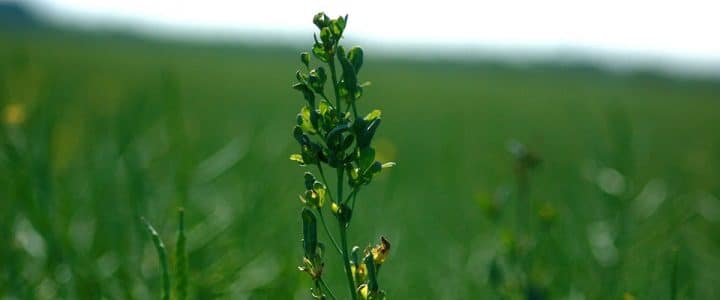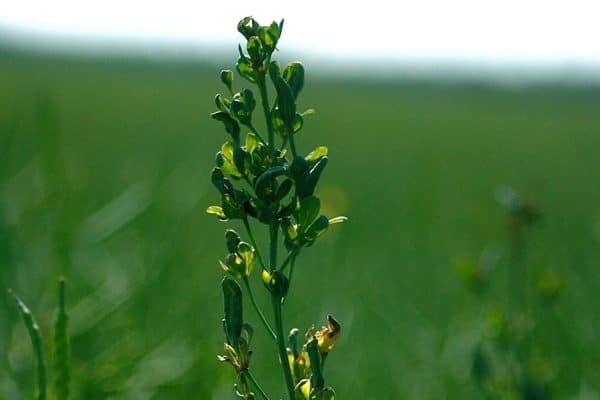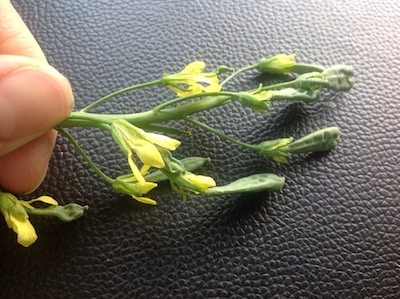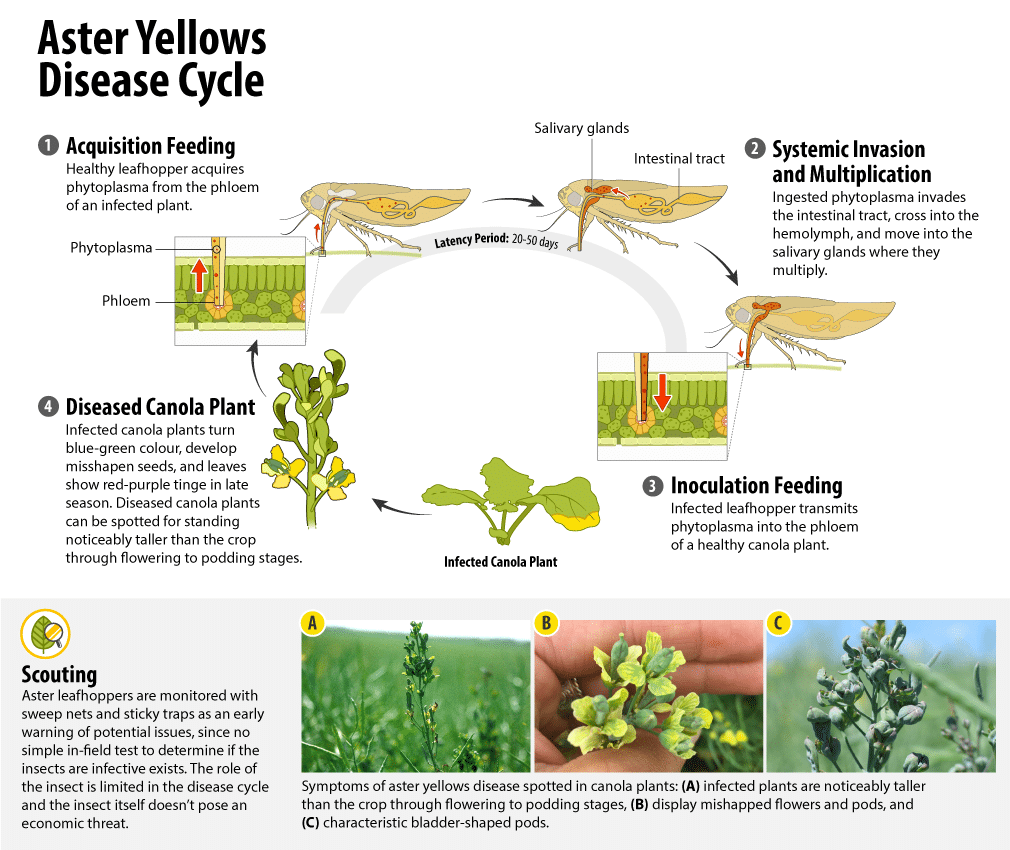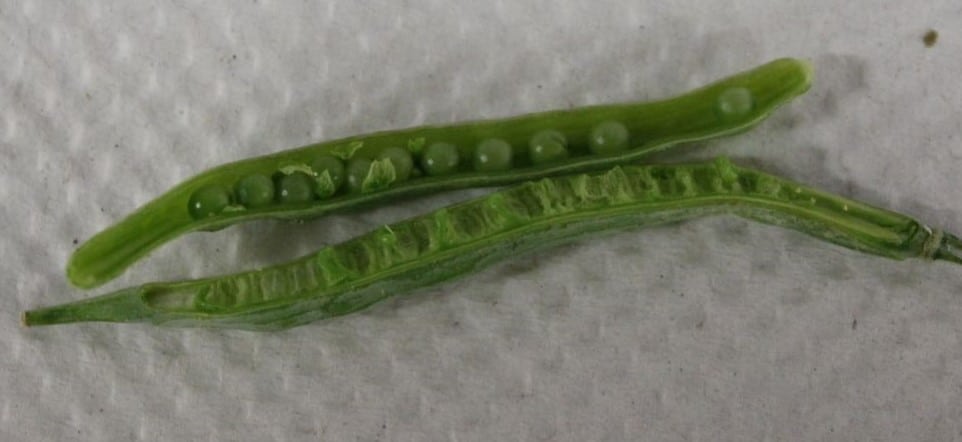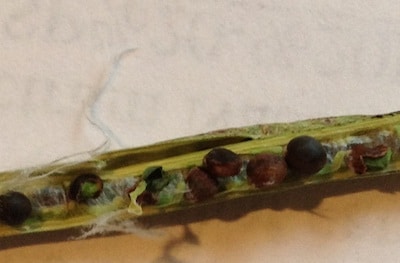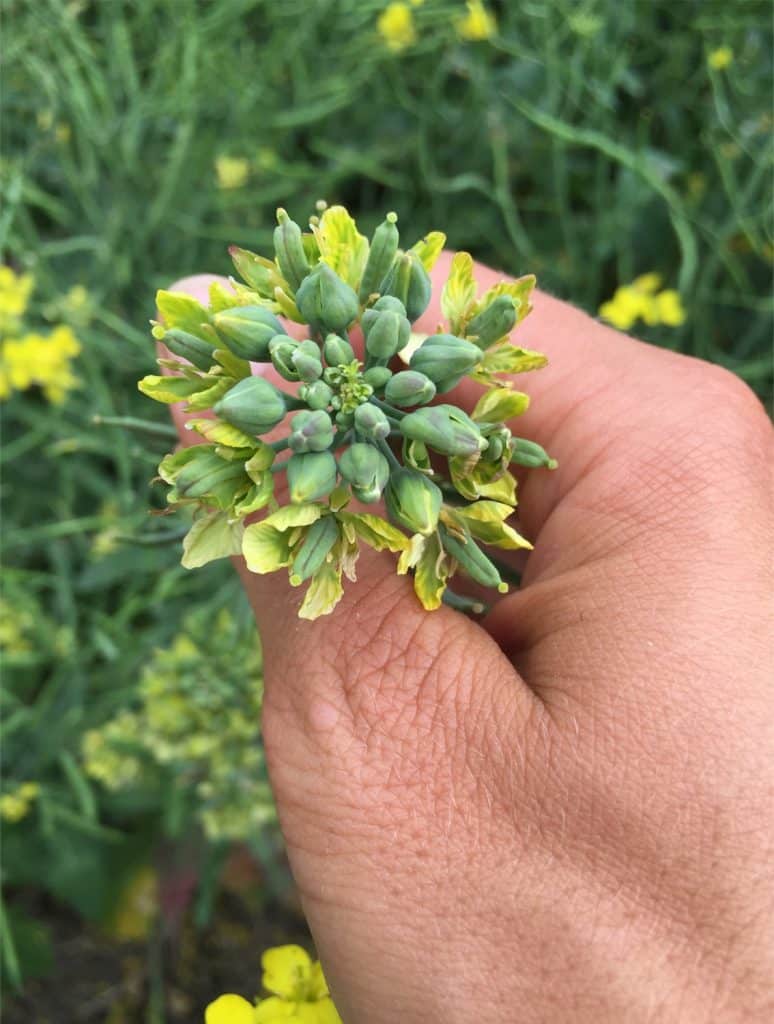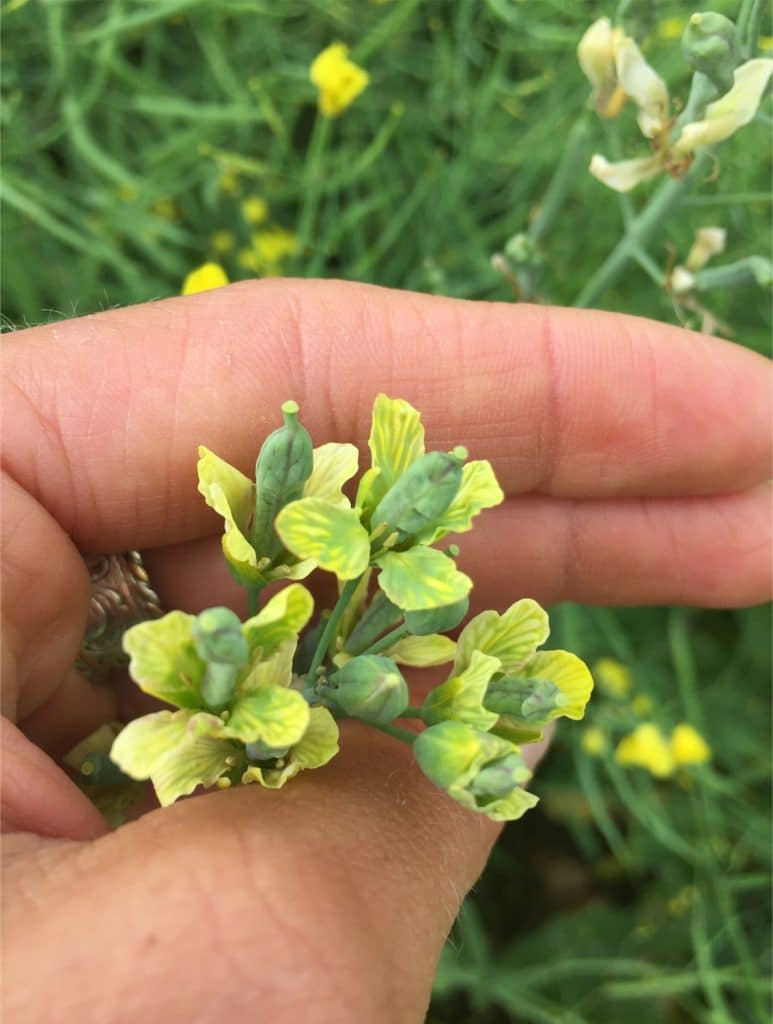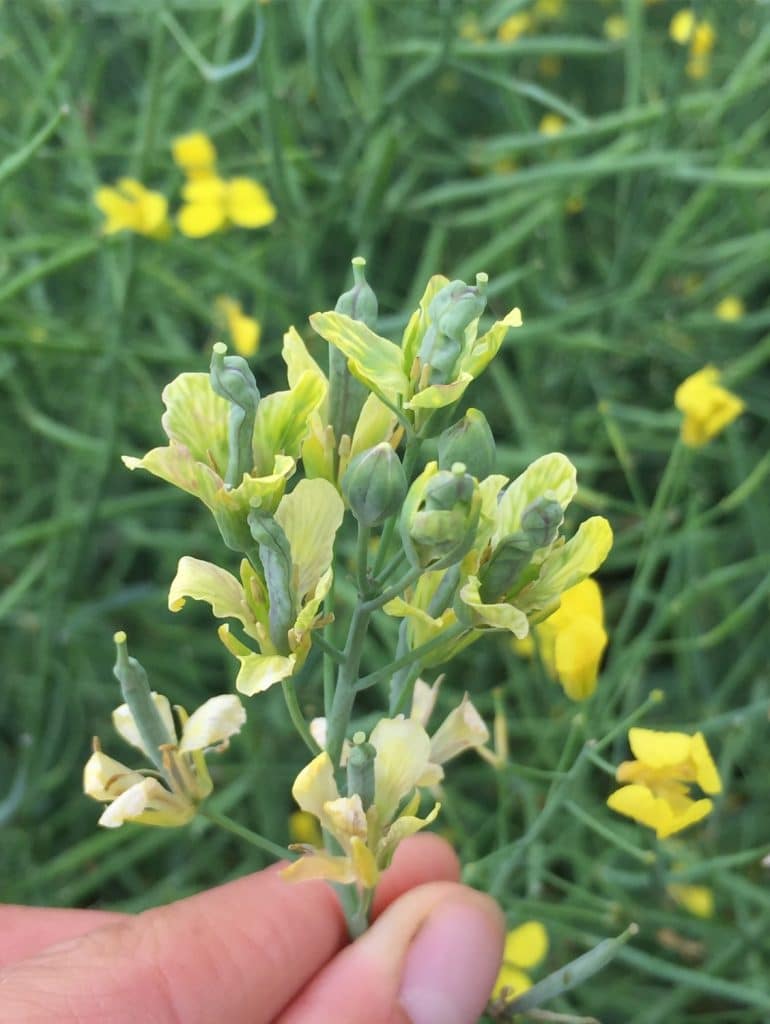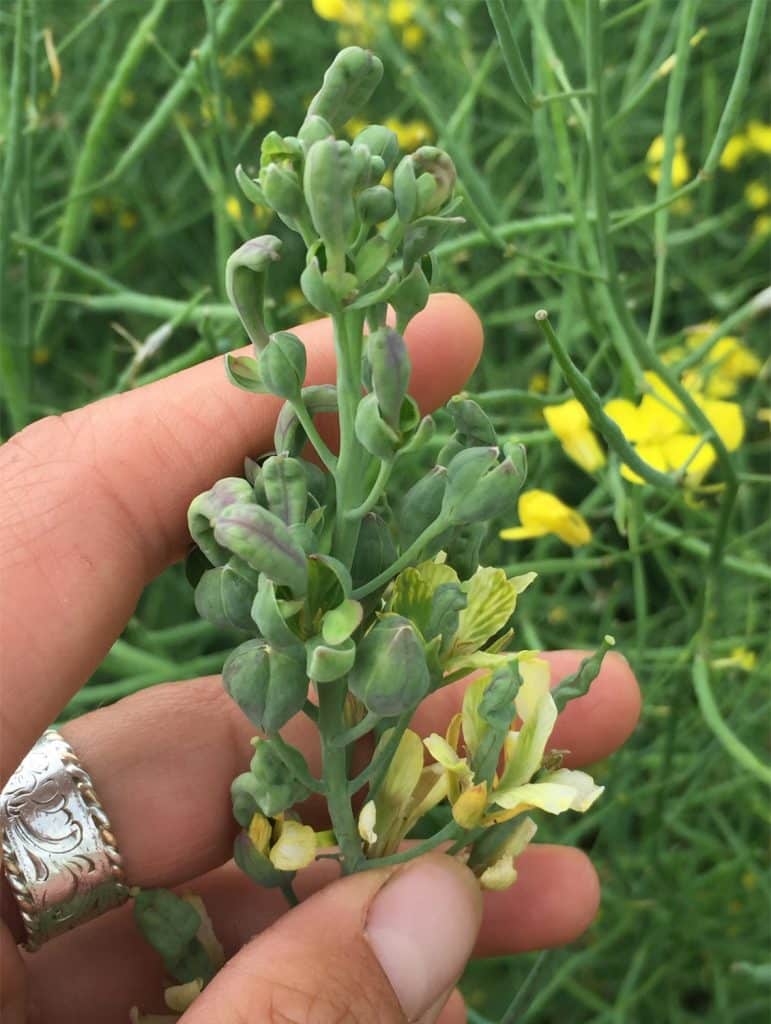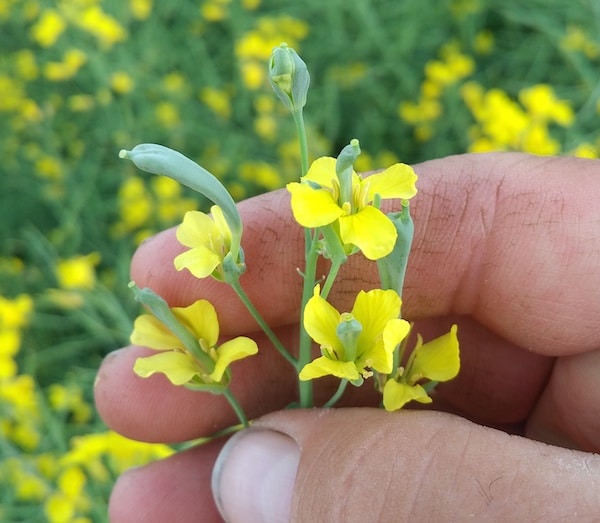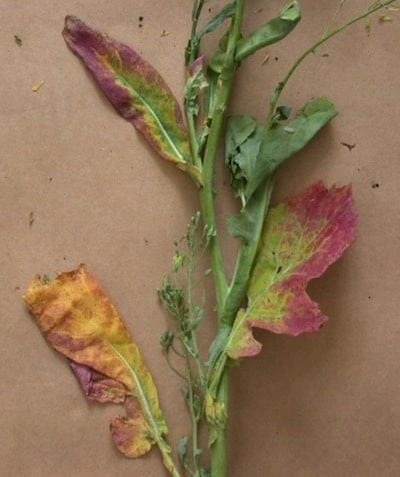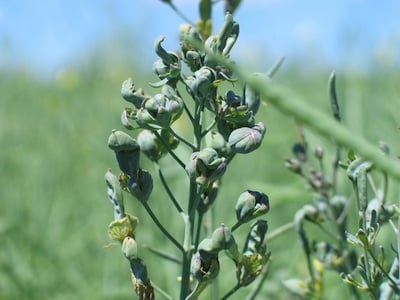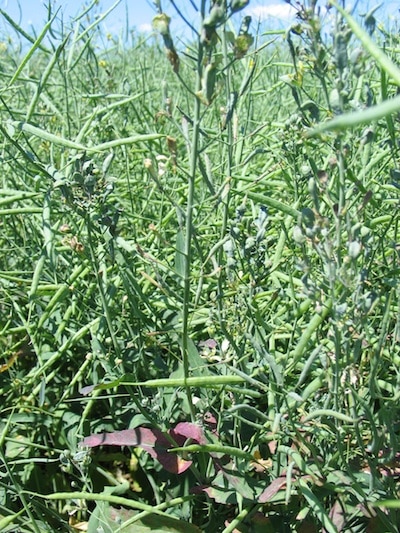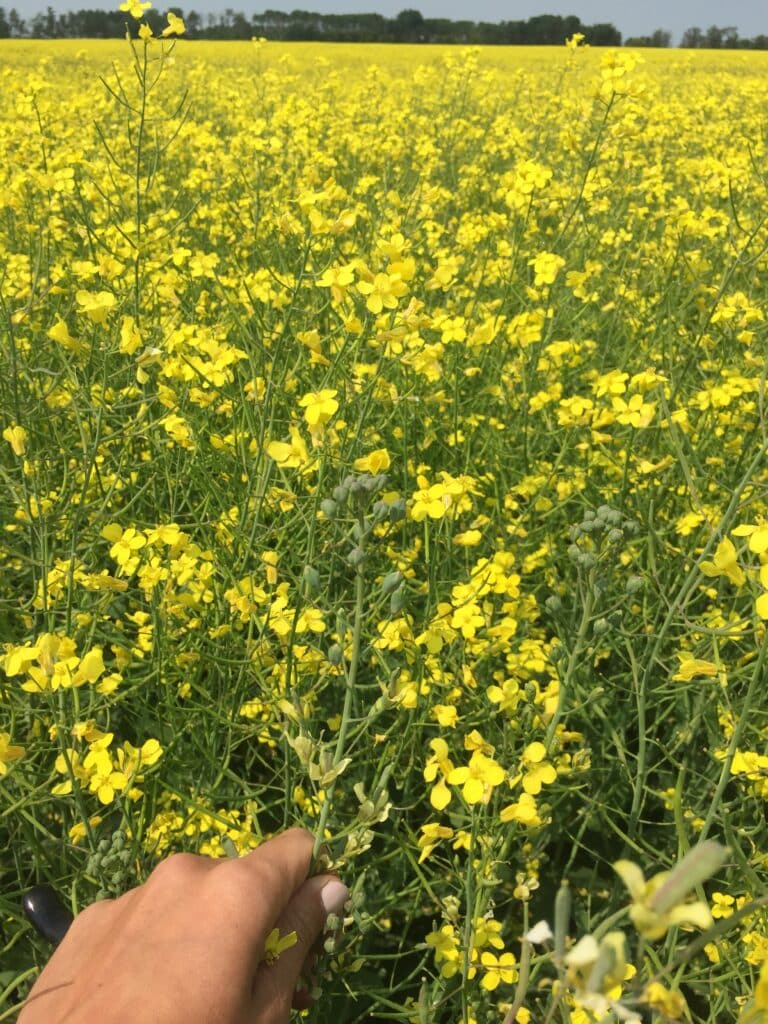Aster yellows is a plant disease in canola which is transmitted by aster leafhoppers infected by the aster yellows phytoplasma (Candidatus Phytoplasma asteris). Canola is one of many known plants hosts for this disease. In most years, aster yellows is a cosmetic disease in canola and does not cause significant yield losses.
Important tips for best management of aster yellows
- Aster yellows disease in canola in transmitted by aster leafhoppers infected with a phytoplasma.
- Symptoms of aster yellows in canola include bladder-like pods filled with leaf-like tissue, green pigmentation of floral parts (virescence) and green flower petals (phyllody). The stems also tend to stand prominently above the crop canopy.
- There are no known curative treatments for plants infected with aster yellows.
- Controlling host weeds in canola and other field crops, may help reduce the incidence of the disease.
- Aster yellows-related research is available on the Canola Research Hub.
Overview
Aster yellows is the only known insect-vectored disease in canola. When spring southern winds bring aster leafhoppers infected with the aster yellows phytoplasma (Candidatus Phytoplasma asteris) up from the southern United States, and conditions in a field are favourable for leafhoppers, watch for aster yellows disease. Infection or transfer of the phytoplasma from infected leafhoppers is more likely to occur when high levels of these infected insects are blown in early, prior to the four-leaf stage of canola.
Aster yellows disease symptoms are often first spotted in plants that are noticeably taller than the rest of the crop (through flowering to podding stages). Infected plants turn a blue-green colour and leaves will show a red or purple tinge late in the season. Sterile, green, leaf-like structures will replace the flower and round or oval, blue-green, hollow, flattened bladder-like structures replace seed-bearing pods in infected plants. Although there have been instances where yield losses have been observed in outbreak years, generally few fields reach an economic level of loss. 1
Disease cycle
Aster yellows in canola is caused by a phytoplasma (Candidatus Phytoplasma asteris) which is an insect-transmitted bacteria. Phytoplasmas reproduce in both host plants and insect vectors. There are over 300 species of plants known to act as hosts for this disease 2, and in Canada this includes cereal, forage, and oilseed crops as well as many weeds. Within the infected host plant (ex. canola) phytoplasmas are restricted to the phloem tissues. Phyotplasmas can overwinter in the roots of biannual and perennial crops, weeds, and wild plants which may act as a reservoir for the pathogenA disease-causing organism (such as a fungus or bacteria). More on the Prairies.
The wind-blown migratory aster leafhopper (Macrosteles quadrilineatus) is responsible for moving most of the aster yellows disease across North America and is the main insect vector that moves this pathogenA disease-causing organism (such as a fungus or bacteria). More from plant to plant. A small proportion of aster leafhoppers may hatch from eggs laid the previous season, but usually very few, if any, adults manage to overwinter in the Canadian Prairies.
There can be more than one generation of leafhoppers in a growing season, and subsequent generations can be re-infected with the phytoplasmas by feeding on plants infected by earlier generations. The development of two generations of migratory leafhoppers may be possible if adults are blown in from during early spring. In addition, other leafhopper species have the potential to spread aster yellows by feeding on a range of hosts (in addition to canola), such as grass ditches or cereal crops 1,3.
Early greenhouse studies indicate that leafhoppers can produce significantly more infection in wet conditions than under dry soil conditions 4.
Incidence of aster yellows is variable in space and over years, which is due to the number of migrating infected adult leafhoppers, overwintering leafhopper eggs, and the presence of infected host plants 5. Climatic factors affect the development of this disease, with hot and dry conditions reducing its risk.
For more information on the insect vectors, please visit Aster Leafhopper.
Symptoms
Characteristic symptoms of this disease are the development of bladder-like pods filled with leaf-like tissue, green pigmentation of floral parts (virescence) and green flower petals (phyllody). While symptoms may be confused with other diseases (ex. purpling or discolouration caused by heat stress or nutrient deficiency), stems of infected canola plants characteristically have little seed set. This reduced weight allows them to stand prominently above the crop canopy. Typically aster yellows disease only affects a low number of individual plants within the canola crop and has limited impact on yield as a result. However, it isn’t uncommon to find a few infected plants (at podding stage) in many fields. Aster yellows outbreak years have been documented in western Canada in 1957, 2000 (two to 15 per cent infection), 2007 (two to 25 per cent infection) and in 2012 with five to 84 per cent infection resulting in a significant yield reduction for many growers across the Prairies 6,4.
Management
There are no known curative treatments for plants infected with aster yellows. In most years, aster yellows is a cosmetic disease in canola and does not significantly cause yield losses.
In an average year, 3–5% of the leafhoppers carry aster yellows phytoplasma 1. In outbreak years when high numbers of infected aster leafhoppers migrate into the Prairies, many crops including canola can be impacted.
In 2012, the only year to date where growers would consider this disease widespread, leafhoppers arrived highly infected (9.1 per cent) in large numbers (126/20 sweeps). In comparison, other years may average less than 10 leafhoppers per 20 sweeps 4.
Controlling the aster leafhopper vector has been used by some horticultural crops like carrots, but this has not been studied or shown to be effective in Canadian field crops, including canola.
There are no known sources of resistance in canola to aster yellows.
Controlling weeds around canola and other field crops, which may act as reservoirs for the aster yellows pathogenA disease-causing organism (such as a fungus or bacteria). More, may help reduce the incidence of the disease.
Footnotes
- Agriculture and Agri-Food CanadaAgriculture and Agri-Food Canada is a department of the Government of Canada. More. 2018. Field Crop and Forage Pests and their Natural Enemies in Western Canada: Identification and Management Field Guide. Retrieved from: http://publications.gc.ca/collections/collection_2018/aac-aafc/A59-23-2018-eng.pdf[↩][↩][↩]
- Kumari, S., Nagendran, K., Rai, A.B., Singh, B., Rao, G.P., Bertaccini, A. 2019. Global status of phytoplasma diseases in vegetable crops. Front. Microbiol., 10 (1349) https://doi.org/10.3389/fmicb.2019.01349[↩]
- Prairie Pest Monitoring Network. 2019. Blog posts on Aster leafhoppers. Retrieved from: http://prairiepestmonitoring.blogspot.com/search/label/Aster%20leafhopper[↩]
- Olivier, C., Dumonceaux, T., Perez-Lopez, E., Wist, T., Elliott, B., & Vail S. 2017. In Integrated Management of Insect Pests on Canola and other Brassica Oilseed Crops. Chapter 16, Detection, Symptomatology and Management of Aster Yellows Disease in Canola, 233-246.[↩][↩][↩]
- Olivier, C. 2007. Aster Yellows chapter in the Compendium of Brassica Diseases. 62-64. Editor S. R. Rimmer.[↩]
- Alberta Agriculture 2014. Aster Yellows and Aster Leafhopper. Agdex 622-31. Available online.[↩]


